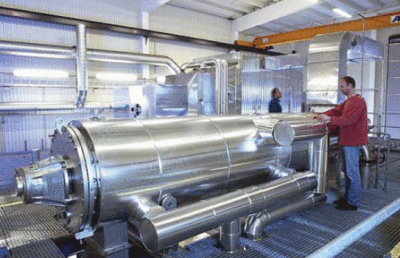
Contact Details:
Degremont (Pty) Ltd
Lincolnwood Office Park – Block F
Woodlands Drive
Woodmead
Gauteng
South Africa
Tel: +27 (0)11 807 1983
Fax: +27 (0)10 591 5095
Send Enquiry | Company Information

Finding Sustainable Solutions
Product News Friday, November 9, 2012: Degremont (Pty) Ltd
Sewage sludge is the end product of wastewater treatment and its processing represents a crucial economic and environmental challenge. Chantelle Mattheus discusses with Degrémont South Africa’s deputy MD, Dumi Luthuli, the technologies that could offer sustainable solutions.
The quantities of sewage sludge produced are steadily on the rise due to both demographic change and increasing urban sprawl, in parallel with the increasing rate of connections to a network and wastewater treatment works. In addition, new international regulations have been introduced that require higher volumes of effluent to be treated to even higher standards, according to Luthuli. Having built approximately 10 000 plants worldwide, sludge treatment is one of Degrémont's five areas of expertise, along with drinking water purfication, desalination by reverse osmosis, wastewater treatment and treated wastewater reuse and industrial water treatment.
Degrémont developed a comprehensive range of technologies adapted to all the elementary processes being a part of the whole sludge treatment line. All those "sub-processes" have been largely enhanced in the recent years. Among them, Luthuli cites the following:
- Anaerobic digestion: This is a stabilisation process, which can be boosted by a preliminary thermal hydrolysis resulting in boosted energy production and an improved filterability of digested sludge. From 5 to 10% additional cake dryness may be obtained on the downstream dewatering devices. Degrémont's Cannon Mixer is the perfect solution to get excellent process conditions and to avoid long-term maintenance problems.
- Mechanical dewatering: Classical mechanical dewatering technologies like Filter Belt Presses, Centrifuges and Plate Filter Presses are well-knows. The benefits and drawbacks of these technologies are also well-known. In order to enhance the dewatering efficiencies and to meet international trends, Degrémont developed the Dehydris Twist dewatering technology. This technology greatly reduces the sludge transportation costs but, more importantly, brings benefits to the upstream processes like thermal drying or incineration, due to high cake dryness.
Using the Dehydris Twist allows gains of 8 to 10% in cake dryness compared to conventional filter belt presses, depending on sludge quality and chemical conditioning.
- Sludge drying: Sludge drying bascially serves the purpose of reducing the final sludge volume and therefore helps to minimise the disposal costs.
Solar or thermal drying are two main routes employed empolyed by Degrémont; the final choice being dependent on the climate, energy costs and plant size.
As far as solar drying of dewatered sludge is concerned, Degrémont has developed and installed dozens of Heliantis or greenhouse facilities equipped with adapted turning machines - the so-called "scarifiers". The Heliantis is simple, clean, ecological and economical technology that utilises 20 to 100 kWh per tonne of water evaporated. Degrémont has built more than 70 thermal drying facilities in the past 60 years. Thermal drying is a very sensitive process that could be dangerous if not properly designed. After extensive research, Degrémont came up with two reliable and efficient processes, namely:
The Evaporis LE (low energy), which consumes 700 to 750 kWh per tonne of water evaporated to be compared with 600 to 1 100kWh for other processes. It is a two-stage process.
The Evaporis LT (low temperature) is a single stage band dryer that uses waste heat (low temperature calories that are generally lost.)
- Incineration: Incineration of dewatered cake by high temperature fluidised bed is now an internationally recongnised process. Degrémont's incineration technology, the Thermylis has numerous outstanding references mostly in North America.
Current strategies are to get autogenous conditions, in order to avoid an injection of external fuel. This can be easily achieved, either by installing an enhanced dewatering device (Dehydris Twist) upstream or by pre-drying coupled with heat exchangers.
For large plants, a direct valorisation of energy with steam turbines driving electrical generators is very interesting - the Galindo Plant in Bilbao, Spain, being an excellent example.
